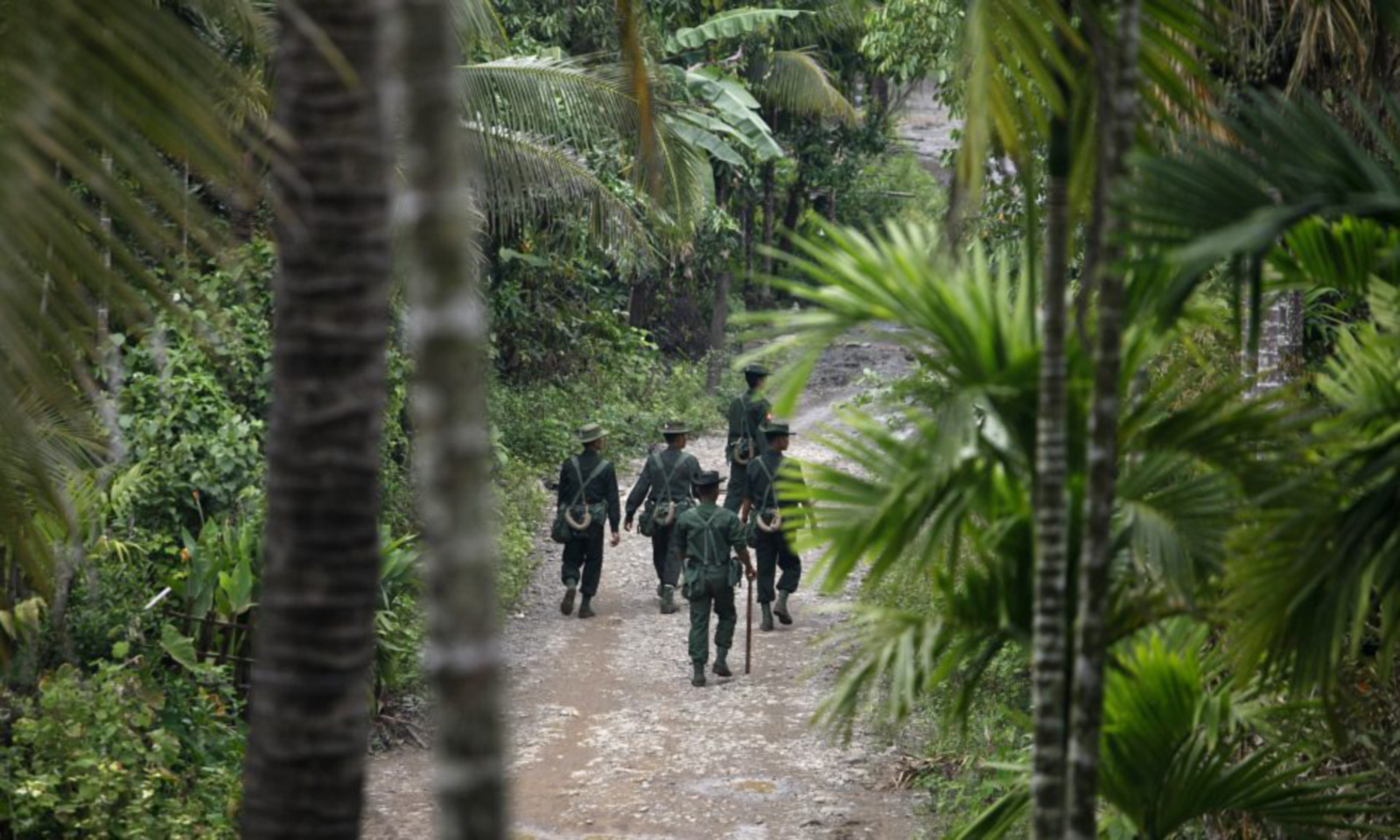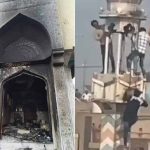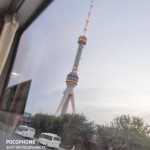The little-known Arakan Army, one of the country’s newest insurgent outfits, is responsible for rising violence in the country’s remote western regions By David Scott Mathieson
The stirring soundtrack of the video ‘Dream in Our Heart’ is accompanied by statements of defiance by ethnic Rakhine soldiers, male and female, of the Arakan Army (AA) from their mountain redoubt in Myanmar’s northern Kachin State. Army commander Major General Twan Mrat Naing (aka Tun Myat Naing) speaks to the camera: “Our message to Naypyidaw and Burmese army is we will never ever give up, we will fight until we achieve our objective.”That objective, articulated in the video widely distributed online, is the total liberation of Myanmar’s Rakhine State from “Burmese fascism” and the Myanmar army which has long occupied Rakhine State and oppressed its people.The little known Arakan Army is unique in that as one of Myanmar’s smallest ethnic armed organizations (EAOs) still fighting the central government, it operates in four ethnic states at either end of this large country: far from ‘home’ in Kachin and northern Shan States, and in the west in the borderlands of Chin and Rakhine State, where many of the groups fighters hail from.Formed in April 2009, the AA’s central aims are self-determination for the Arakan people, to safeguard national identity and cultural heritage and promote ‘national’ dignity. Its political wing, the United League of Arakan (ULA), was formed soon after the militant wing.
The army partly formed as a response to widespread frustration amongst young Rakhine with the largely moribund Arakan Liberation Party/Army (ALP/A) and its political wing based on the Thailand-Myanmar border, which only ever operated alongside the large Karen National Liberation Army (KNLA) and not for many years in Rakhine State.The ALP signed the Nationwide Ceasefire Agreement in October 2015, and some of its members have voiced support for the AA and condemned allegations of Myanmar army abuses against its supporters. Most international understanding of ethnic Rakhine grievances stem from the long persecution of Rohingya Muslims and communal violence which rocked the state in 2012. But this obscures long-standing resentment of decades-long of neglect by the Myanmar state which has made Rakhine State one of Myanmar’s least developed and poverty wracked areas.
The AA explicitly uses the colonial era Arakan terminology, rejecting ‘Rakhine’ as a Myanmar term that implicitly sees the Rakhine as second class citizens, and that fuels broader Myanmar ridicule of the Rakhine as yokels who speak a tortured dialect of the Burmese language, akin to the dismissal of people from the Deep South in the United States.The Kingdom of Arakan was sacked by the Myanmar kings in the 15th Century, and evidence of this rich cultural heritage is preserved in the ancient ruins of Mrauk-U.Drawing on disaffected migrant workers from the Hpakant jade mines, the AA was hosted and trained by the Kachin Independence Army, one of Myanmar’s oldest and most sophisticated insurgent groups. Within two years, the AA was on the frontline alongside its Kachin allies, after the 17-year ceasefire between the Kachin and government collapsed in 2011, leading to heavy fighting which displaced over 100,000 civilians, hundreds of civilian casualties and destroyed villages, and combatant casualties numbering in the several thousand.The AA operates in Northern Shan State as part of the Northern Alliance, which includes the Kokang-Chinese Myanmar Democratic Alliance Army (MNDAA), the Ta-ang National Liberation Army (TNLA), and Brigades 4 and 6 of the Kachin Independence Army. Underscoring the bewildering relationships of the Myanmar civil war, the Arakan Army also operated alongside ethnic-Myanmar soldiers of the All Burma Students Democratic Front (ABSDF) until that group signed the Nationwide Ceasefire Agreement (NCA) in October 2015.The alliance has markedly stepped up operations against government targets, including the November 20, 2016 attack on the China-Myanmar border trade city of Muse, in which several civilians were killed and injured, bridges blown up, and the subsequent seizing of the border town of Mong Ko, before alliance fighters were driven from the town by the Tatmadaw’s use of heavy artillery and air-strikes.
The Northern Shan State fighting has been largely eclipsed by international attention on the repression of the Rohingya Muslims in Rakhine State, but it seizes domestic attention far more because of its marked intensification in recent years.The Alliance assault on the former MNDAA stronghold of Laukkai in March, in which AA troops took part, included attacks on the main hotel and casino in which civilians and policemen alike were targeted, and allegedly scores of men and women were abducted as human shields during the insurgents retreat into the hills.The AA’s participation in these northern operations for the past several years is predicated on the expansion of their trained and battle-tested fighters to open a front in their home state. As early as 2013, Rakhine political leaders were lobbying the previous government of U Thein Sein to open an area for AA fighters to relocate from Kachin State to Rakhine State, although with little support from the government.
In 2015, the AA opened a new area of operations in the borderlands of Buthidaung, Kyauktaw, and Mrauk-U townships of Rakhine State, and Paletwa township of Chin State close to the Bangladesh border. In several bouts of fighting between the AA and the Tatmadaw, the military admitted to losing several troops, including officers to Arakanese sniper fire.The Tatmadaw reported 15 clashes between December 28, 2015 to January 4, 2016 in which large amounts of weapons and ammunition were captured. Fighting flared again in April and May, and in December 2016 in Paletwa, as Tatmadaw troops continued to sweep the area to interdict AA movements along the borderlands.According to AA sources, the Tatmadaw have deployed ten battalions from their Western Command and Military Operations Command 15 based in Buthidaung to pacify their movements in three townships (Infantry battalions 374, 375, 376, 539 in Kyauktaw, 377, 378, 540 in Mrauk U, and 379, 380 and 540 in Min Bya).The current size of the AA is difficult to measure. Some estimates place their total numbers at 1,500, which is fairly standard size for many smaller ethnic insurgent groups, while training in the north continues to attract large numbers of male and female recruits. (The KIA numbers around 7,000, while the United Wa State Army has over 25,000 under arms.)The fighting has generated a cycle of dynamic civilian displacement necessitating international and national relief operations to supplement large humanitarian operations that exist for civilians displaced by communal violence in 2012 and responses to natural disasters.The United Nations Office for Coordination of Humanitarian Affairs (OCHA) reported 1,100 IDP’s in eight temporary sites in Kyauktaw, Rathedaung and Buthidaung, and worked with Rakhine relief agencies and the state government to assist civilians.Reports of extortion, ill-treatment and forced recruitment by the AA have increased, which are often countered by allegations of Tatmadaw brutality, including in one statement “witnesses and victims described how the armed forces forcedly (sic) displaced entire villages and destroyed, beatings with the barrel of a gun, executions, gun rape, looting and the burning of their homes.”The fighting has exacerbated tensions between the AA and ethnic Chin civilians in Paletwa, and has sparked public criticism by Chin leaders and reports from the Chin Human Rights Organization that AA soldiers have been abducting Chin civilians, using others as forced labor, and planting landmines around civilian areas.Chin political parties have condemned both sides of using of landmines without apportioning specific blame for reports of widespread human rights violations. Just days ago, Indian media reported that an estimated 300 Chin civilians, predominantly women and children, had fled Myanmar to seek sanctuary in Mizoram in northeast India, claiming that the AA had detained the men from Ralie village inside Chin State.
The AA dismissed these allegations in a statement posted to Facebook, and alleged that renegade Arakan Liberation Army soldiers were masquerading as AA forces to extort money from civilians and discredit the insurgent outfit. In such isolated settings, verifying various allegations of abuses is almost impossible.The Myanmar military has responded to the the AA’s increased operations in Rakhine State with a wave of arrests of civilians suspected of providing material support to the insurgents. According to the Assistance Association for Political Prisoners-Burma, 58 Rakhine civilians have been sentenced under Section 17(1) of the Unlawful Association Act, with eight more facing trial while in detention in Sittwe Prison.Bonds between Rakhine politicians, activists and the AA are tight: Maj-Gen Twan Mrat Naing’s father-in-law is the Rakhine State parliamentary Speaker of the House, U Saw Kyaw Hla. In early April, the authorities stopped a fund-raising football match in Mrauk-U, dubbed the ‘Arakan Army Cup’ during the annual Thingyan water festival, and arrested a Buddhist abbot Nanda Thara and a lay supporter Khaing Ni Min charging them under Section 505 of the Penal Code related to causing public alarm or inciting people to violence.These arrests have evinced widespread protests throughout Rakhine State and contribute to a sense of persistent Burman persecution of the Rakhine, the dismissal of their political aspirations, the continued plunder of their natural resources with only perfunctory development projects from the central state to assuage them.
Further antagonizing Rakhine political leaders, in May 2016 the national parliamentary speaker U Win Myint blocked a proposal by ANP MP Daw Khin Saw Wai for an urgent discussion on aid for civilians displaced by fighting between the AA and Myanmar army, because, the speaker said, the proposal was predicated more on raising the issue to push for inclusion of the AA in the nationwide ceasefire process.
The AA attended the Union Peacemaking Conference in Naypyidaw, having been invited as part of the Northern Alliance, facilitated by the Chinese special envoy to the peace talks. But the AA’s attendance comes after two years of official denunciations of their activities, with statements from both the military and State Counsellor Aung San Suu Kyi being all but identical, demanding the group disarm and then seek peace. Defense Minister Lieutenant General Sein Win told the national parliament the AA had to cease its activities and sign the controversial nationwide ceasefire agreement. In a statement from Suu Kyi in March, she warned the non-signatories to the ceasefire that the only way to achieve peace was to sign, and to be ‘extremely careful’ in how they respond to that condition.
Exactly how does the AA pay for all this expanding activity? Given their popularity in Rakhine State, tax collection not just amongst supporters in their home state, but the many thousands of migrant workers in peri-urban factories of Yangon and the jade mines of Kachin State and Sagaing Region would be lucrative. Involvement in the drug trade cannot be ruled out. In one of the most evocative front pages of the state-run newspaper Global New Light of Myanmar, in February 2016, the headline boldly proclaimed ‘How to Fund a War’, outlining a series of raids and arrests of AA officers in Yangon in which large numbers of arms and ammunition were seized, and reportedly 330,800 methamphetamine pills, or yaba.The AA issued a ‘condemnation letter’ on the same day refuting the allegations as “childish and undignified” and blamed the Myanmar military for being the main player in the drug trade. Reporting on the drug trade in Rakhine State is perilous: last March the Sittwe home of the online editor of the Root Investigation Agency, Min Min, was bombed and the journalist forced to flee to Yangon.
International analysts reporting on restive Rakhine State guardedly claim that the AA has rarely publicly articulated anti-Rohingya or anti-Muslim sentiments, even though many AA officers will privately declare that Rohingya are all Bengali illegal immigrants and should leave: a position identical to the Myanmar army and many ultra-nationalist activists in the country.This changed recently, however. Following the coordinated attacks on Myanmar Border Guard Police outposts in Maungtaw by suspected Rohingya militants of the Harakah al-Yaqin (Faith Movement, later renamed as the Arakan Rohingya Salvation Army), the ULA/AA issued a press release which called the militants “savage Bengali Muslim terrorists” and the violence a “rampage of the Bengali Islamic fundamentalist militants in Northern Arakan.”
The statement furthermore said “(The bordered area (sic) of the Northern Arakan and other cities such as Rangoon (Yangon) are now suffering adverse effects as a result of Arakan’s bordering with the population explosion of Bangladesh, the excessive entering of illegal Bengali immigrants into Arakan for decades and the neglect of the successive Burmese regimes to the Bengali’s intrusion and territorial expansion.” There is little likelihood that the AA’s attendance at the largely symbolic Panglong 21st Century will make any real headway in addressing Rakhine grievances, and the expansion of their armed operations looks set to continue.The intense nationalist messages expressed by Maj Gen Twan Mrat Naing and the AA troops under his command are widely held in Rakhine State, where resentment against the Myanmar state and military is widespread, and often misunderstood by the outside world which identifies Rakhine political grievances as being primarily driven by anti-Rohingya sentiment.This lack of understanding of the AA’s armed revolt will only further postpone the resolution of the conflict and prolong the communal divisions that have generated conflict in Rakhine State for years. This is a dimension of the civil war in Myanmar that is only getting worse, not better, and is dangerously misunderstood.
‘Courtesy Asia Times Online’.







